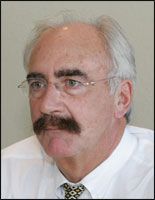Publication
Article
Pharmacy Times
Editor's Note: Evidence-Based Health Care Reform
Author(s):
Diverse practice settings and avoiding cumbersome new bureaucratic requirements should be taken into account when developing evidence-based health care guidelines.
Mr. McAllister is a health-systemsconsultant based in Chapel Hill,North Carolina.

Several pharmacist colleagueswere discussing the USP 797sterile compounding regulationand the challenges of implementationin order to comply with the JointCommission standards. One of the discussionparticipants was a pharmacyresident who asked why a particularstandard had been created. Severalof us responded to the question withour assumptions and anecdotes thatseemed germane to the issue.
The resident seemed satisfied withthe cumulative answer, and the discussionproceeded to strategies toresolve the issue for that particularhospital.
I made a note to myself and revisitedthe issue and concluded that wereally had not answered the resident’squestion with supporting data. I beganan online search about the issue, anddespite numerous articles and evensome published research related tothe issue and the standard, none ofthe data in the public domain wouldpass as evidence-based research withthe appropriate controls and scientificrigor that we would expect to evaluatea new drug for formulary addition.
I am not picking on the USP 797 regulationor the Joint Commission standards,both of which have undoubtedlyhelped improve health care andpatient safety. Like other health carereform initiatives, the regulation andstandards are well-intentioned expectationsdeveloped by incredibly brightand trusted thought leaders frommany disciplines. New regulationsand standards result in a myriad ofchanges, frequently requiring reallocationof resources, including staff, if notadditional resources.
Unfortunately, these changes sometimesrequire that other programs orservices are eliminated or substantivelyamended, without regard to relativevalue. Progress through change isoften a very good thing, but given theincreasing complexity of health caredelivery, the diversity among organizedhealth care settings, and thesetough financial times for everyone, I suggest that we consider all processesof reform to ensure appropriate scientificrigor as an integral part of futureregulatory development or reformprocesses.
I am old enough to rememberwhen the American Society of Health-System Pharmacists (ASHP) used topromulgate various “standards.” Ourcollective good fortune is that ASHPleaders, including staff, realized thatASHP should be developing guidelineson various issues which individualhospitals or health systems could usein the development of policies thatadd value to patient care processes.I was not part of that philosophicalshift, but I suspect that ASHP recognizedthat although these guidelinedocuments were developed with considerableinput from thought leaders,staff, and the membership (throughthe House of Delegates oversight processes),they were not necessarilyevidence-based, especially for diversepractice settings. Their adoption orapplication by organizations shouldbe based on their needs and reviewof their data.
In President Barack Obama’s"Plan for a Healthy America" (www.barackobama.com), one of the basicstrategies to lower health carecosts and make high-quality healthcare available for everyone calls forincreased investment in "comparativeeffectiveness reviews and research."Whereas at first glance this may beencouraging, the description of theinitiative reflects a plan to make decisionsusing information "…developedby reviewing existing literature, analyzingelectronic health care data, andconducting simple, real-world studiesof new technologies." The statementgoes on to describe intentions “toestablish an institute to guide reviewsand research on comparative effectiveness...”
It seems to me that we already haveplenty of bureaucratic infrastructurefocused on data review and analysis.I would like to see these funds grantedto researchers in diverse practicesettings that perform well-controlledcomparative trials focused on targetedfederal and state objectives sothat similar organizations can use andapply the findings to their institutions.What do you think?







